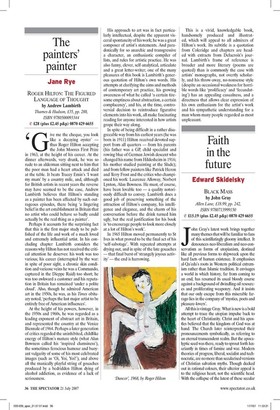The painters' painter
Jane Rye ROGER HILTON: THE FIGURED LANGUAGE OF THOUGHT by Andrew Lambirth Thames & Hudson, £35, pp. 288, ISBN 9780500093344 © £28 (plus £2.45 p&p) 0870 429 6655 G‘ lye me the cheque, you look like a decaying oyster' — thus Roger Hilton accepting the John Moores First Prize in 1963, at the height of his career. At the dinner afterwards, very drunk, he was so rude to an alderman sitting next to him that the poor man had a heart attack and died at the table. It beats Tracey Emin's 'I want my mum' by a country mile, and, although for British artists in recent years the reverse may have seemed to be the case, Andrew Lambirth believes that Hilton's standing as a painter has been affected by such outrageous episodes, there being 'a lingering belief in the art establishment in Britain that no artist who could behave so badly could actually be the real thing as a painter'.
Perhaps it accounts for the surprising fact that this is the first major study to be published of the life and work of a much loved and extremely influential artist. In his concluding chapter Lambirth considers the reasons why Hilton has not received the critical attention he deserves: his work was too various; his career (interrupted by the war: in spite of poor sight, a chronic skin condition and varicose veins he was a Commando, captured in the Dieppe Raid) too short; he was too awkward a customer and his reputation in Britain has remained 'under a polite cloud'. Also, though he admired American art in the 1950s, he was, as his Times obituary noted, 'perhaps the last major artist to be entirely free of American influences'.
At the height of his powers, however, in the 1950s and 1960s, he was regarded as a leading exponent of abstract art in Britain, and represented the country at the Venice Biennale of 1964. Perhaps a later generation of critics regarded the uninhibited, childlike energy of Hilton's mature style (what Alan Bowness called his 'inspired clumsiness'), the sometimes ferocious humour and buoyant vulgarity of some of his most celebrated images (such as `0i, Yoi, Yoi!'), and above all the manically playful string of gouaches produced by a bedridden Hilton dying of alcohol addiction, as evidence of a lack of seriousness.
His approach to art was in fact particularly intellectual, despite the apparent visceral spontaneity of his work; he was a great composer of artist's statements. And paradoxically for so anarchic and transgressive a character, an enthusiastic compiler of lists, and rules for artistic practice. He was also funny, clever, self-analytical, articulate and a great letter-writer; one of the many pleasures of this book is Lambirth's generous quotation of Hilton's own words. His attempts at clarifying the aims and methods of contemporary art practice, his growing awareness of what he called 'a certain tiresome emptiness about abstraction, a certain complacency', and his, at the time, controversial decision to reintroduce figurative elements into his work, all make fascinating reading for anyone interested in how artists grope their way along.
In spite of being difficult in a rather disagreeable way from his earliest years (he was born in 1911) Hilton received devoted support from all quarters — from his parents (his father was a GP, child specialist and rowing blue of German Jewish descent who changed his name from Hildesheim in 1916; his mother studied painting at the Slade); and from fellow painters like Patrick Heron and Terry Frost and the critics who championed his work: Laurence Alloway, Norbert Lynton, Alan Bowness. He must, of course, have been lovable too — a quality notoriously difficult to convey. Lambirth does a good job of preserving something of the attraction of Hilton's company, his intelligence and elegance, and the charm of his conversation before the drink turned him ugly, but the real justification for his book is 'to encourage people to look more closely at a lot of Hilton's work'.
In 1965 Hilton moved permanently to St Ives in what proved to be the final act of his 'self-sabotage'. With repeated attempts at drying out, and in spite of the late gouaches — that final burst of 'strangely joyous activity' — the end is harrowing.
This is a vivid, knowledgable book, handsomely produced and illustrated, which will appeal to all admirers of Hilton's work. Its subtitle is a quotation from Coleridge and chapters are headed with extracts from Delacroix's journal. Lambirth's frame of reference is broader and more literary (poems are quoted) than is commonly the case with artists' monographs, not overtly scholarly, and his throw-away, no-nonsense style (despite an occasional weakness for horrible words like 'prolificacy' and 'fecundating') has an appealing casualness, and a directness that allows clear expression of his own enthusiasm for the artist's work and his sympathetic understanding for a man whom many people regarded as most unpleasant.












































 Previous page
Previous page